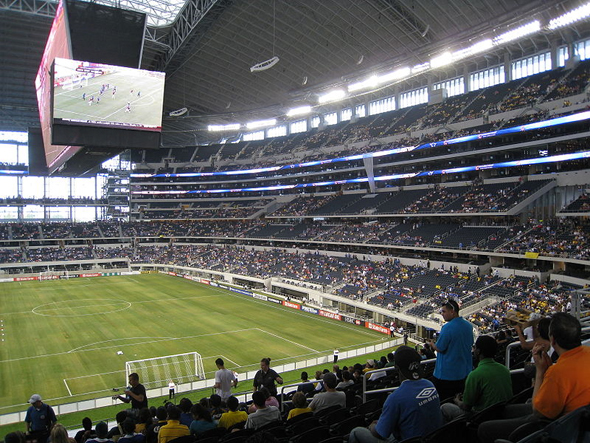Between Dallas and Forth Worth, next to Rangers Ballpark in Arlington, Texas. the new Cowboys Stadium is three times larger than the NFL team’s previous home at Texas Stadium in nearby Irving.
At $1.2 billion, it’s the league’s most expensive stadium to date, although that price tag is due to be eclipsed by the Jets-Giants new $1.6 billion stadium next year.
The entire Statue of Liberty and its base would fit inside the stadium with the roof closed, as would the American Airlines Center arena in Dallas. At 104 million cubic feet – Houston’s Reliant Stadium in is 90 MCF – the Cowboys new home is the NFL’s largest enclosed stadium.
The roof is supported by two 35- by15-foot arched box trusses that are 1,300 feet long – more than twice the length of the Gateway Arch in St. Louis – making it the longest clear-span structure in the world. Back-to-back 72- by 160-foot high-definition video screens – the largest in the world – stretch between the 20-yard lines.
Seating capacity is 80,000, but with additional ticketed seating and standing room in the end zone plazas, total capacity can swell to 100,000.
Cowboys Stadium is also now the world’s largest Electro-Voice installation, including virtually every type EV line array backed by an intensive NetMax control system.
Sound system designer was Kevin Day of consultant firm Wrightson, Johnson, Haddon & Williams (WJHW) of Dallas, which counts major league stadiums as one of its specialties, and installation and custom engineering services were supplied by San Francisco Bay-area vendor ProMedia/UltraSound, with Demetrius Palavos serving as project manager. The EV team also provided technical support on the project.
“I decided early-on that the stadium required a line array solution,” Day remarks. “I had used EV line arrays in other projects and heard them in several touring productions. I was quite pleased with the sound and impressed with the accuracy of the performance data. Not all line array products out there have accurate data for predicting system performance. The fact that these systems could also be integrated with a system control platform as powerful as IRIS-Net and NetMax made EV the strongest choice.”
The stadium’s audio control room on the upper suite level employs a Yamaha M7CL-48, chosen for its straightforward single layer design, fitted with a pair of AES MY cards for digital inputs from playback devices next door in Video Control.
Local audio inputs include a Tascam CD player, recorder and tuner, Sony multi-disc CD and DVD changers, a Mackenzie Labs message repeater, and a Click Effects ProAudio PC playback system for “Rock and Roll, Part 2” and other crowd-rousers. The announcer’s mike so far has been a Shure SM58 on a Symetrix AirTools vocal processor.
Another pair of MY cards feed the M7CL to back-of-house locations and accepts remote inputs via CobraNet, including an SKB rolling rack with a Whirlwind ES2 16 x 16 digital snake chassis for inputs and outputs on the field. Four Shure PSM 600 IEM systems are available for entertainment and the “anthem” wireless mics are Shure UHF-R with Beta 87A capsules.





















